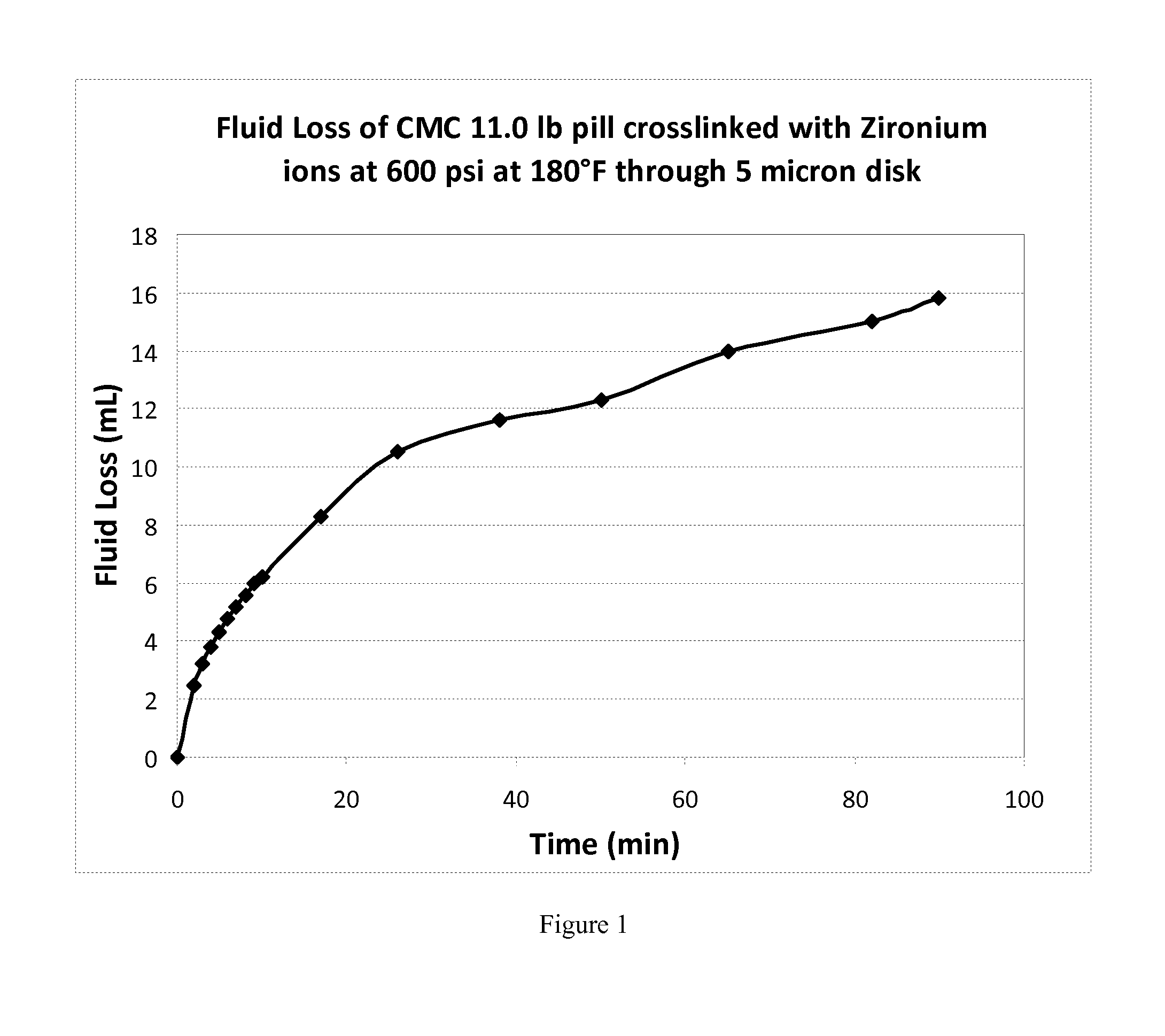Fluid Loss Control Composition and Method of Using the Same
a technology of composition and composition, applied in the direction of sealing/packing, chemistry apparatus and processes, borehole/well accessories, etc., can solve the problems of loss of circulation, loss of fluid into the formation, loss of fluid,
- Summary
- Abstract
- Description
- Claims
- Application Information
AI Technical Summary
Benefits of technology
Problems solved by technology
Method used
Image
Examples
example 1
[0059]General procedure for preparation of CMC based pill: To check the suitability of CMC as a fluid loss control pill a 120 lb / Mgal of CMC gel in tap water was prepared (Table 1). To a Waring Blender was added 1000 mL of tap water slowly adding carboxymethylcellulose (FDP S951-09(Halliburton product) (14.4 g) with stirring to prepare 120 lb / Mgal gel. The gel was allowed to hydrate for 30 minutes. The pH of all the 10 pills was adjusted to about 6 (Pill 1 to pill 4 and pill 6 to pill 9). 100 mL of the hydrated gel was placed in a jar and an appropriate amount of crosslinker (zirconium-based crosslinker CL-23 (Halliburton product) for pill 1 to pill 4 or Aluminum-based crosslinker FDP S961-09 (Halliburton product) for pill 6 to 9) was added. The material was transferred to a glass jar and kept in the water bath maintained at 180° F. After 30 minutes in the bath a marble was placed on top of the gel. The position of marble was measured from the upper surface periodically until the ma...
example 2
[0061]In another experiment, a weighted CMC pill with sodium bromide was prepared. CMC gel (120 lb / Mgal) was prepared in tap water and, after hydrating the gel, enough NaBr (276 in 1000 mL aqueous gel) salt was added to the gel to make approximately 10 lb / gal density pill. Then pH of the gel was adjusted to 5.9 with HCl and the gel was crosslinked with an appropriate amount of CL-23, as indicated in Table 3. The material was transferred to a glass jar and kept in the water bath maintained at 180° F. After 30 minutes a marble was placed on top of each of the pills. The position of the marble was observed to check the stability of the gel. The results of the test are shown in Table 4. It appeared that most of the pills are stable at 180° F. with various amounts of crosslinker.
TABLE 3120 lb / Mgal CMC pill crosslinked with CL-23containing NaBr brine (density ~10 lb / gal)ComponentPill 11Pill 12Pill 13Pill 14CMC gel100 mL100 mL100 mL100 mLCL-23 0.5 mL 0.6 mL 0.7 mL 0.8 mLpH to5.545.565.595....
example 3
[0062]In another experiment, a weighted 120 lb / Mgal CMC pill with zinc bromide was prepared. 7.2 g of CMC was first blended with 12 mL of glycerol to make a paste. This operation help prevent “fish eyes” when hydrating CMC in water. 96 mL of water was added to the CMC / glycerol paste in a Waring Blender and shear for 5 min. 392 mL of 19.2 lb / gal ZnBr2 brine was then slowly added to make a 16.9 lb / gal fluid. The solution was sheared for 15 minutes then left at room temperature for one hour. Then pH of the gel was adjusted to 5.9 with HCl and the gel was crosslinked with an appropriate amount of CL-23, as indicated in Table 5 (pill 15 to pill 18). The material was transferred to a glass jar and kept in the water bath maintained at 180° F. After 30 minutes a marble was placed on top of each of the pills. The position of the marble was observed to check the stability of the gel. The results of the test (pill 15 to pill 18) are shown in Table 6. Pill 17 is stable for at least 25 hours at ...
PUM
| Property | Measurement | Unit |
|---|---|---|
| density | aaaaa | aaaaa |
| diameter | aaaaa | aaaaa |
| pH | aaaaa | aaaaa |
Abstract
Description
Claims
Application Information
 Login to View More
Login to View More - R&D
- Intellectual Property
- Life Sciences
- Materials
- Tech Scout
- Unparalleled Data Quality
- Higher Quality Content
- 60% Fewer Hallucinations
Browse by: Latest US Patents, China's latest patents, Technical Efficacy Thesaurus, Application Domain, Technology Topic, Popular Technical Reports.
© 2025 PatSnap. All rights reserved.Legal|Privacy policy|Modern Slavery Act Transparency Statement|Sitemap|About US| Contact US: help@patsnap.com

